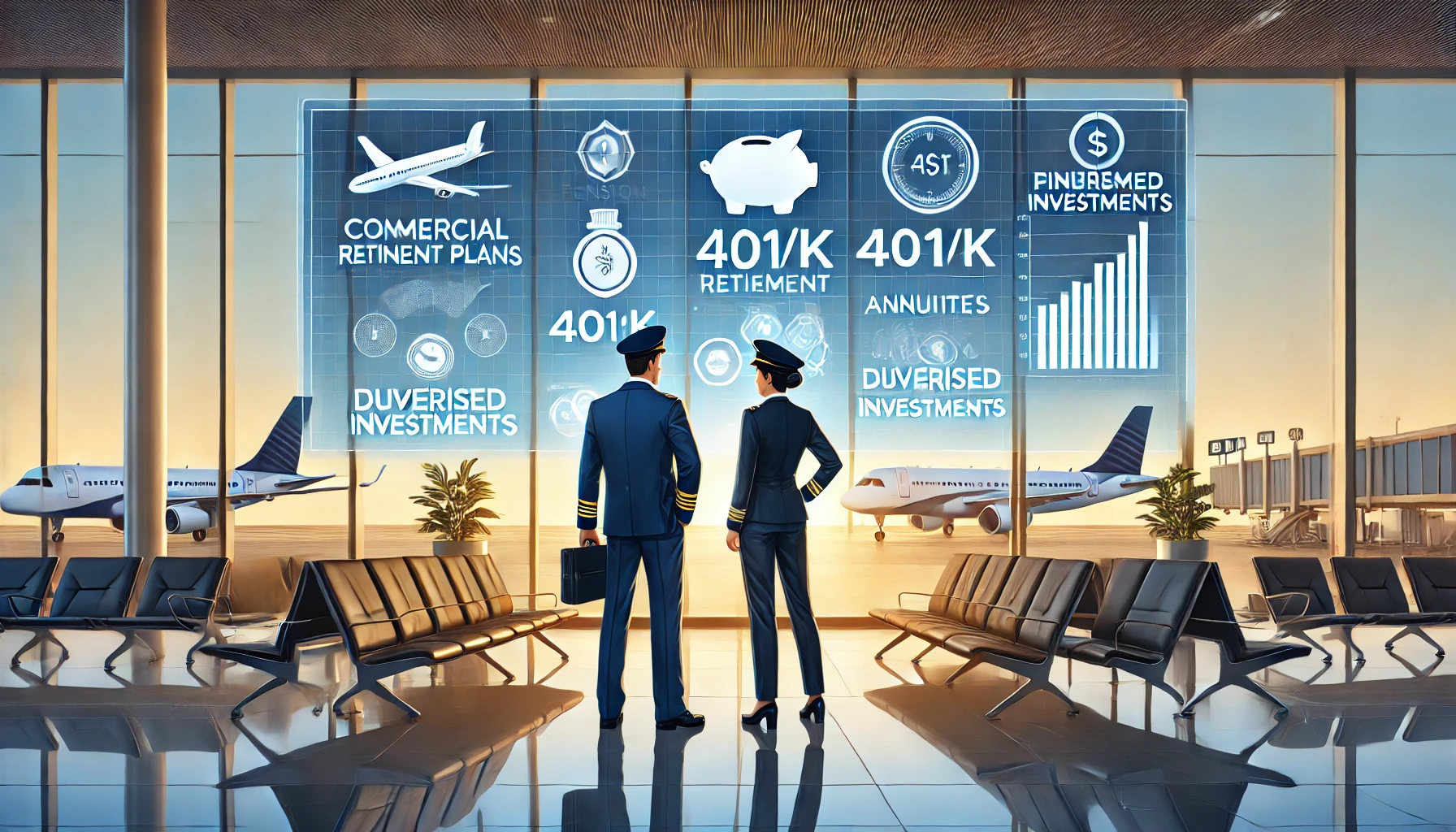Retirement planning is essential for everyone, but pilots have unique challenges that require specialized financial strategies. Unlike many professions, pilots face mandatory retirement ages, fluctuating incomes, and industry-specific pension structures. Whether you are an airline captain or a self-employed private pilot, securing a solid financial future requires careful planning.
Why Retirement Planning is Unique for Pilots
Pilots have distinct retirement needs due to:
- Mandatory Retirement Age: The FAA requires airline pilots to retire at 65.
- Variable Income: Overtime, bonuses, and economic downturns impact earnings.
- Pension Changes: Airline pensions have shifted from defined benefit to defined contribution plans.
- Independent Work: Many private pilots work as contractors and need self-funded plans.
Given these factors, it is crucial for pilots to explore all available retirement options to ensure financial stability.
Understanding Airline Pilot Retirement Plans
Most major airlines offer a combination of:
- 401(k) Plans with Employer Matching
- Defined Benefit Pension Plans (Legacy Pilots)
- Deferred Compensation Plans
- Profit-Sharing Contributions Airline pilots should take full advantage of these options to maximize their retirement savings.
Private Pilot Retirement Plans: What’s Available?
Private pilots who work independently or on contracts need to establish their own retirement savings strategies. Options include:
- Traditional or Roth IRAs
- Solo 401(k) Plans
- SEP-IRAs
- Taxable Investment Accounts Since private pilots do not have employer-sponsored pensions, they must actively manage their own financial future.
401(k) Plans for Airline Pilots
Most airlines offer a 401(k) retirement plan, with employer matching contributions of up to 16% in some cases. Pilots should aim to:
- Maximize Contributions ($23,000 limit in 2024, plus $7,500 for those 50+)
- Take Full Advantage of Employer Matching
- Diversify Investments for Stability A well-managed 401(k) is one of the best ways for airline pilots to build long-term wealth.
IRA Options for Private Pilots
Since private pilots do not have company-sponsored plans, they should consider:
- Traditional IRA: Pre-tax contributions lower taxable income.
- Roth IRA: Tax-free withdrawals in retirement.
- SEP-IRA: Ideal for pilots with self-employment income, allowing contributions up to 25% of earnings. Choosing the right IRA depends on current and future tax expectations.
Defined Benefit Pension Plans for Airline Pilots
While traditional pension plans have largely disappeared, some senior airline pilots still benefit from:
- Fixed Monthly Pension Payments
- Lifetime Annuity Options
- Survivor Benefits However, newer airline pilots must rely primarily on 401(k) savings instead of pension guarantees.
Defined Contribution Plans: A Growing Trend
Since the 2000s, airlines have shifted to defined contribution plans, such as:
- 401(k) Profit Sharing
- Cash Balance Plans
- Deferred Compensation Accounts Understanding these plans helps pilots maximize their retirement income.
Solo 401(k) for Private Pilots
Private pilots running their own business can set up a Solo 401(k), allowing them to contribute:
- Employee Contribution ($23,000 in 2024)
- Employer Contribution (Up to 25% of income) This is a powerful retirement tool for self-employed pilots.
Maximizing Employer Contributions
Pilots should ensure they:
- Contribute Enough to Get Full Employer Match
- Invest for Growth with a Balanced Portfolio
- Use Additional Savings for Tax Diversification Employer contributions are essentially free money that should not be left on the table.
Social Security Benefits for Pilots
Pilots should factor in Social Security benefits, but should not rely on them entirely. Benefits are based on:
- Lifetime Earnings
- Age of Claiming (62-70) Many pilots delay Social Security until 67 or later for higher payouts.
Best Retirement Locations for Pilots
To make retirement funds last, pilots should consider tax-friendly states such as:
- Florida (No state income tax)
- Texas (No state income tax)
- Nevada (Lower cost of living) Relocating to a pilot-friendly state can preserve more retirement income.
You Can Also Read : Maximizing Retirement Benefits for Pilots: What You Need to Know
The best retirement plans for airline and private pilots depend on individual career paths and financial goals. Whether relying on 401(k) employer contributions, pension plans, or self-directed SEP-IRAs, pilots must take proactive steps to secure their financial future. Early and strategic retirement planning will ensure a comfortable and financially stable post-flying life.
FAQs
How much should airline pilots save for retirement?
Pilots should aim to save at least 15-20% of their income annually, leveraging employer matches and tax-advantaged accounts.
Do pilots get Social Security?
Yes, but benefits vary based on lifetime earnings and claiming age. Many pilots delay Social Security for larger payouts.
Are pensions still available for airline pilots?
Some senior pilots still receive pensions, but most new pilots rely on 401(k) and defined contribution plans.
What is the best retirement plan for private pilots?
Private pilots should consider Solo 401(k), SEP-IRA, or Roth IRA plans for tax-efficient savings.
At what age do airline pilots retire?
FAA regulations require airline pilots to retire at 65, though private pilots can fly as long as they meet medical requirements.
